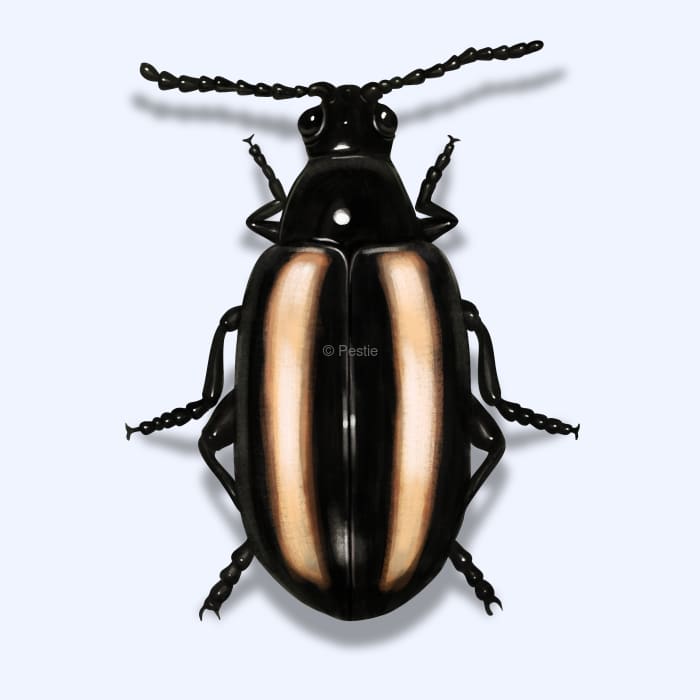How to identify and get rid of flea beetles

Flea beetles: Small but mighty foes
When we think about fleas, we think about jumping insects on our pets and sometimes on us. But did you ever stop to think that your favorite plants also have their own tiny jumping pests to deal with too!
Flea beetles get their name from the strong hind legs that allow them to leap long distances when disturbed. They love to chew tiny holes in our indoor plants or outside gardens.
While they aren't difficult to control, they can be an unwelcome surprise to many homeowners and gardeners. Hundreds of species share the name flea beetle, but many specialize on specific plants and crops.
Common flea beetles in the US include:
- Potato flea beetle
- Crucifer flea beetle
- Striped flea beetle
- Spinach flea beetle
- Corn Flea Beetle
Female flea beetles like to lay eggs at the base of their preferred plant, and the larvae hatch and begin feeding on the roots. The adults will chew small holes in the leaves. The damage can often kill a plant or stunt growth.
These highly mobile beetles aren't all bad, though. Many can be beneficial by eating certain weeds in your yard, too.
How to identify flea beetles
Flea beetles are tiny, jumpy pests that love to chew on your plants. You can spot them by their shiny, dark bodies and superhero-like ability to leap great distances. If they've started moving into your garden or landscaping, you'll notice small, round holes in the leaves of your plants, almost as if someone's been doing miniature target practice. These holes are the tell-tale sign of a flea beetle infestation.
How big are flea beetles?
Flea beetles are small, typically ranging from 1/16 to 1/8 inch long, but there is one species that can be up to ¼ inch long.
What other pests look like a flea beetle?
There aren't many beetles that can jump like flea beetles, but they can be mixed up with leafhoppers if you aren't looking at them carefully. Leafhoppers can jump, too, but flea beetles will have a round, shiny body.
Weevils are sometimes mistaken for flea beetles, but they don't jump and typically have a longer snout.
Where do flea beetles live?
Flea beetles can be found throughout the United States. They thrive in gardens, farms, and greenhouses, but you can also find them on any flowers or ornamental plants you might have in your yard. They love the sunny spots around your home.
Luckily, they aren't a major pest on houseplants, and if you do find them inside, it's most likely because they've hitchhiked inside when you brought a plant in.
How to get rid of flea beetles
If you don't want to spray your plants with pesticides, there are a few alternative ways to eliminate flea beetles.
First, make sure you are confident that you have a flea beetle problem. This means you will need to monitor for them with yellow sticky cards and frequently check leaves for any signs of flea beetles.
Here are some things you can do if you suspect a flea beetle infestation on your plants:
- Control weeds around your garden and home
- Remove any dead or dying plants
- Use transplants instead of direct sowing
- Use row covers to exclude flea beetles
- Plant companion plants like thyme, catnip, and mint to repel beetles
- Use radishes as a trap crop – the beetles prefer this over your garden
Additionally, you can use a perimeter spray that creates an insect barrier around your home and garden. Pestie offers DIY pest control plans that are easy to use without having to spend hundreds of dollars on traditional sprays and exterminators. Now, you can get pro-grade solutions for year-long protection customized for your location.
Treat flea beetles with Pestie
If you're still having trouble keeping flea beetles away, the best option is to use a pro-grade, effective pest control solution like Pestie.
Pestie is a do-it-yourself pest control solution that's specially designed to keep flea beetles and other pests away from your home.
With Pestie, you can rest easy knowing that your living space is protected and free of creepy crawlies. And the best part? It's designed for people, pets, and the planet, so you can say goodbye to harsh chemicals and hello to peace of mind!
- Save hundreds compared to traditional annual pest plans
- People, pet, and planet-friendly
- Pro-grade customized formulas
Quick facts
- Scientific name
Family - Galerucinae
- Colors
Metallic black, brown, red, or green with orange and white markings
- Life span
1 year
- Diet
Leaves and roots of cruciferous vegetables, flowers, and ornamental plants
How dangerous are Flea Beetles?
Low danger risk
Flea beetles don't carry diseases, don't bite or sting, and aren't harmful to humans, pets, or structures.
While their jumping ability isn't as impressive as actual fleas, flea beetles accelerate so fast when they jump that they exert forces that are 93 to 230 times that of gravity!








